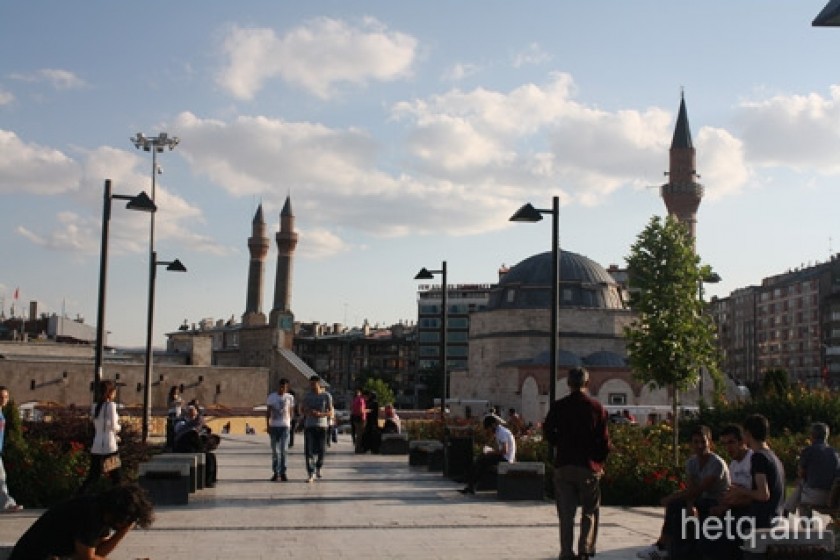
The Armenians of Present Day Sebastia: Finding At Least One Armenian in Each Village
When I was in the first grade, my teacher would point to a map of historic Armenia and tell us that the Turks wanted to leave just one Armenian on those lands as a museum artifact.
This was the first notion that entered my brain when I first stepped foot in Sebastia and conversed with residents of Armenian lineage.
One can find at least one Armenian in each borough and village of this region of Turkey that once boasted a large Armenian presence; every Armenian is
I later found out that the author of those words was none other than Prince Grigory Golitsin who served as Governor of Transcaucasia from 1897-1904. According to the Armenian historian and writer Leo, he was the one who penned the “Armenia without Armenians” motto.
Many historians have shown that overall, in terms of anti-Armenian promulgations and speeches, the Russian Empire exceeds Ottoman Turkey. Due to Soviet historiography, however, many in Armenia are under the incorrect impression that these words were mouthed by Sultan Abdul Hamid or Talaat Pasha and not an official of the Russian Empire. The Armenian poet Paruyr Sevak set the record straight in his work, The Unsilenceable Belfry.
Sivas (Sebastia) is a city in central Turkey and the seat of Sivas Province. The province is said to have a population of 620,000 and the city itself, 300,000.
The remaining Armenian community numbers a mere 30 families – 100 individuals.
Only one of them, Yervant Miktis, knows Armenian. He owns an eyeglass store in the center of town. He learnt Armenian during his stay in Istanbul. When I visited, Yervant was in Istanbul.
Even in Istanbul, with its 16 Armenian schools, the language of conversation amongst Armenians is Turkish. Even Pakrat Estukyan, the editor of the Armenian edition of Agos confesses that he speaks to his friend in Turkish and that Armenian is akin to a museum artifact.
Speaking Armenian was much more problematic in the interior provinces of Turkey. Any manifestation of Armenian identity was a source of fear and parents would prohibit their children form speaking Armenian.
“Even today, people are afraid to say they are Armenian, despite the fact that there is no longer anything to fear,” says Mourat, an Armenian from Sebastia. He learnt Armenian in his home town.
Mourat Tyonter (Armenian surname Kizirian), left Sivas for Istanbul at the age of 15. He then relocated to France.
His father operated a water mill in Sebastia. Needing someone in the community to mill grain for bread, the local Turks left the family alone. Mourat says that after moving to Istanbul, the family wanted to relocate to Armenia but due to the Soviet regime it wasn’t possible.
Mourat says that there were 150 families still residing in Sebastia in 1948. That’s when he learnt Armenian.
“There were meetings in the upper districts where some women who still knew Armenian taught the language,” he says.
Mourat had visited Sebastia after touring Armenia for a week with a group of the remaining Armenians in the town.
Walking through the central streets of the town together, he would point to the new stores and tell me what Armenian artisan or trader used to occupy the spot thirty years ago.
One Armenian we met along the way was Yervant Turmajoglu (Trtotian), who sews military uniforms and sells military odds and ends in his cramped store.
He tells me that the area once had more than forty churches and monasteries. Over the years, all were destroyed except for Saint Kevork Church. It remains on property under the control of the Turkish military. There is talk of renovating the church that is encircled with barbed wire.
The nearest function Armenian church is St. Gregory the Enlightener in Kesaria (Kayseri). A priest from Istanbul holds services in the church several times a year to fulfill the spiritual needs of the area’s Armenian faithful.
The cemetery, containing the remains of some 100 Sebastia Armenians, is new. A building is being constructed over the old cemetery. Only one of the gravestones had Armenian writing. The other inscriptions were in Turkish. Many had no inscription at all.
Yervant told me that the Union of Sebastia Armenians wants to trace the names of these unknown souls and place memorial plaques on their resting sites.
The gates to the cemetery remain closed. Yervant has one set of keys and the other set is in the hands of a caretaker hired by local Armenians.
In its overall appearance, Sivas is a modern city and very clean. Unlike Diyarbekir, there are little traces of the old city.
When Christian tourists visit Sivas they are automatically taken to a gravestone without any inscription, but which locals claim is the burial site of Saint Blaise.
It is a small plot encircled in basalt stone with a rose bush inside. Osman Akyuz, a reporter with local TV58, said that Saint Blaise was an Armenian Catholicos and that they were shooting a film about him. But the reporter confessed that credible source material as to his identity doesn’t exist.
After a long internet search, I discovered that Saint Blaise (Armenian:Sourb Barsegh; Greek: Agios Vlasios), was a 4th century physician and bishop of Sebastia who, according to tradition, was beaten and beheaded.
There is nothing in the historical record to claim that he was Armenian. Nevertheless, he is honored as a saint in the Armenian Apostolic, Roman Catholic and Eastern Orthodox churches.
A list of prominent Sebastia Armenians includes the writer Daniel Varoujan, Mhkitar of Sebastia (founder of the Mkhitarist Order) and the painter Haroutiun Galentz.
 Videos
Videos Photos
Photos
Comments (13)
Write a comment